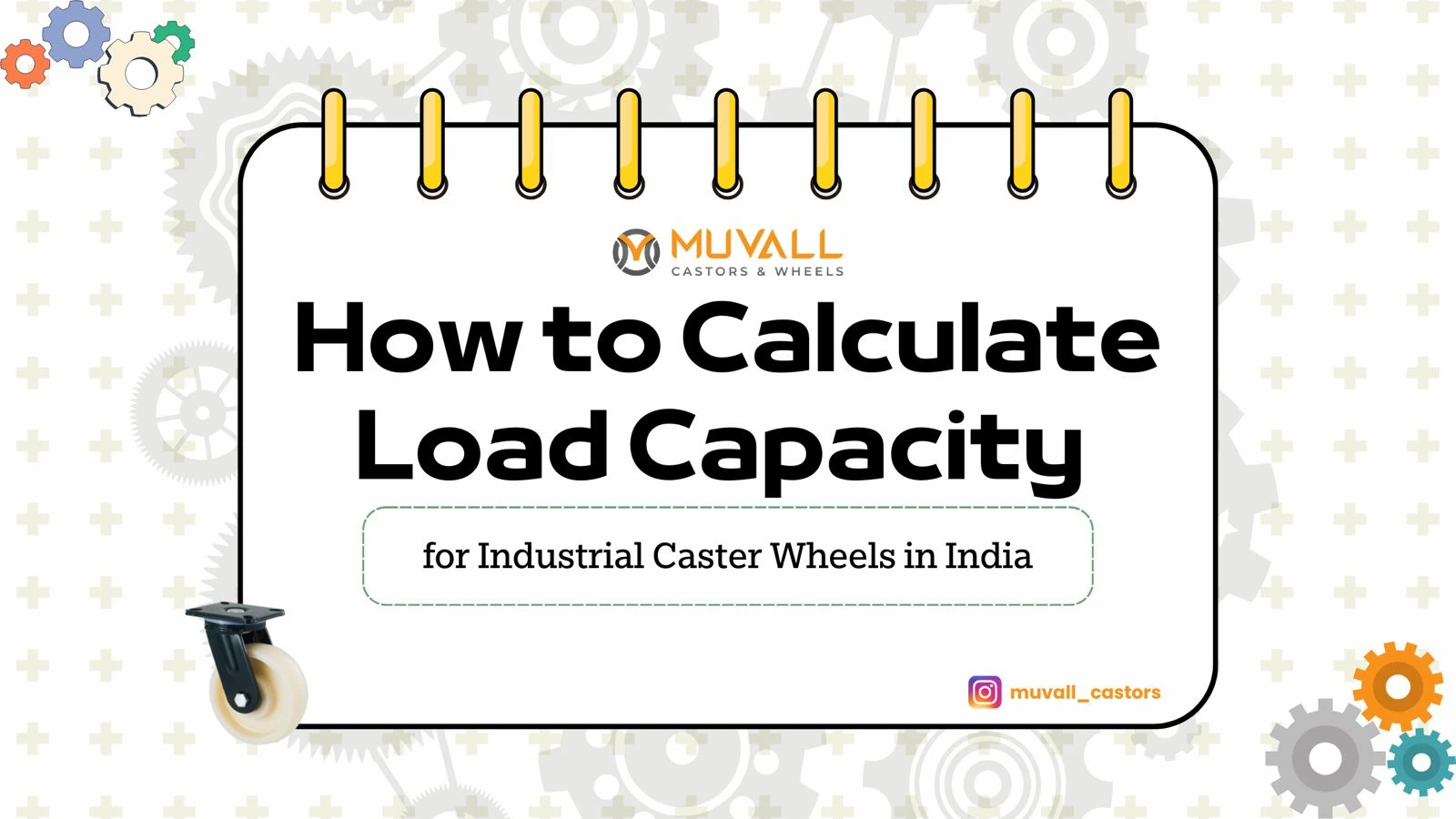
Choosing the right Industrial caster wheel starts with a reliable load calculation. Below is a clear, India-focused, step-by-step guide (with examples) based on Muvall’s 2025 technical catalog. I’ll show the formula, how to pick a safety factor for Indian factory/warehouse conditions, and other practical checks you must run before buying.
1) The basic formula (exact)
Use this formula to calculate required capacity per wheel (W):
W=(L1+L2)×SnW = \dfrac{(L_1 + L_2) \times S}{n}W=n(L1+L2)×S
Where:
L₁ = weight of the load (kg)
L₂ = tare / equipment weight (kg)
n = number of wheels supporting the load
S = safety factor (dimensionless) — depends on speed, floor condition, and application
This formula and approach are taken directly from the Muvall catalog guidance on determining load requirements.
2) How to choose the Safety Factor (S)
Muvall provides recommended safety factor ranges depending on operating conditions. Use the higher end of a range when in doubt (uneven floors, frequent impacts, outdoor use, or automated lines):
Manual operation, speed < 4 km/hr
Even flooring: S = 1.2 – 1.5.
Uneven/outdoor flooring: S = 1.5 – 2.0.
Manual operation, speed 4–6 km/hr
Even flooring: S = 2.2 – 2.5.
Uneven/outdoor: S = 2.5 – 3.0.
Automated / continuous / high-impact systems — use the higher end of the catalog ranges or consult engineering for dynamic force analysis (catalog warns to include allowances for automated systems).
Tip: for typical Indian warehouse trolleys moved by hand on decent concrete, S = 1.5 is a common conservative choice. For rough factory floors or exterior yards choose S = 2.0 or higher.
3) Worked numeric examples (digit-by-digit)
Example A — Warehouse trolley (typical)
Load (L₁) = 1000 kg (pallet + goods)
Tare (L₂) = 200 kg (trolley frame)
Wheels (n) = 4
Condition: manual push, even concrete floor, speed < 4 km/hr → choose S = 1.5.
Step-by-step:
Sum weights: L₁ + L₂ = 1000 + 200 = 1200 kg.
Multiply by safety factor: 1200 × 1.5 = 1800 kg total required capacity (with margin).
Divide by wheels: 1800 ÷ 4 = 450 kg per wheel.
So choose castor wheels rated ≥ 450 kg each. (If using wheels rated exactly 450 kg, keep maintenance and environment checks in mind; choosing the next standard size up is prudent.)
Example B — Heavy duty cart on uneven shopfloor
Load = 2000 kg, Tare = 300 kg, n = 6 wheels, floor = uneven/outdoor → pick S = 2.0.
L₁ + L₂ = 2000 + 300 = 2300 kg.
2300 × 2.0 = 4600 kg.
4600 ÷ 6 = 766.67 kg per wheel → round up to ≥ 770 kg per wheel (choose nearest standard higher capacity).
Use digit-by-digit arithmetic like the examples above to avoid rounding mistakes.
4) Other factors that change the calculation or final selection
The numerical result (W) is only the starting point. Match W with wheel material, diameter, bearings and castor design:
Wheel material vs floor — PU is best for concrete/epoxy floors; nylon wheels/PP for dry smooth floors; UHMW/phenolic for high temp or chemical exposure. Use the catalog’s wheel vs floor mapping when deciding material.
Wheel diameter — larger wheels roll easier over obstacles and reduce rolling resistance (recommended for higher loads).
Bearings — double ball bearings or tapered/thrust bearings reduce starting resistance and handle higher dynamic loads (super heavy duty wheels may use multiple bearings).
Mounting & castor body — forged steel, fabricated steel, or pressings differ in strength; for high loads prefer forged or properly fabricated heavy-duty castors.
Ergonomics & push–pull — even if per-wheel rating is OK, excessive push/pull force is a safety concern. Muvall recommends push-pull evaluation; recommended human force limits are cited in the catalog (initial/sustained force guidelines).
5) Practical selection checklist (before you buy)
Calculate W exactly using the formula and pick S based on floor/speed. (See examples.)
Round W up to nearest standard wheel rating available (don’t underspec).
Confirm wheel material fits floor & environment (PU, PUCB, UHMW, nylon, phenolic, etc.).
Check wheel diameter — larger for uneven floors.
Verify bearing type on chosen castor (double ball / tapered / thrust for heavy duty).
Confirm castor body (forged/fabricated) and plate/stem dimensions match your mounting.
Run a push–pull test on a prototype trolley to confirm ergonomic forces are acceptable.
6) Quick reference table (common scenarios)
Scenario Suggested Safety Factor S Note
Manual, even concrete, low speed (<4 km/hr) 1.2 – 1.5 Typical warehouses.
Manual, uneven/outdoor 1.5 – 2.0 Yard, rough shop floors.
Manual, faster (4–6 km/hr) 2.2 – 2.5 When carts are moved fast.
Automated / high impact 2.5 – 3.0 (or higher) Perform dynamic analysis.
7) Common mistakes to avoid
Using catalog static rating without safety factor — catalog ratings often assume manual use at low speed; always apply S.
Ignoring floor type — a wheel chosen for epoxy might fail on metal chips or rough concrete.
Undersizing bearings / castor body — wheel load capability only matters if the castor body and bearings can handle the forces.
People Also Read: How the Right Number of Caster Wheels Can Ease Heavy Load Movement
8) Short example for Indian users — ready checklist to run now
Measure load (L₁) and tare (L₂).
Count number of wheels (n). Typical: 4 or 6.
Pick S from the table above based on your floor (choose higher if unsure).
Compute W = (L₁ + L₂) × S ÷ n (do the math digit-by-digit).
Select wheel type (PU for indoor concrete; PUCB for heavy-duty; UHMW for corrosive).
Confirm castor body, bearings, and plate/stem dimensions match equipment.